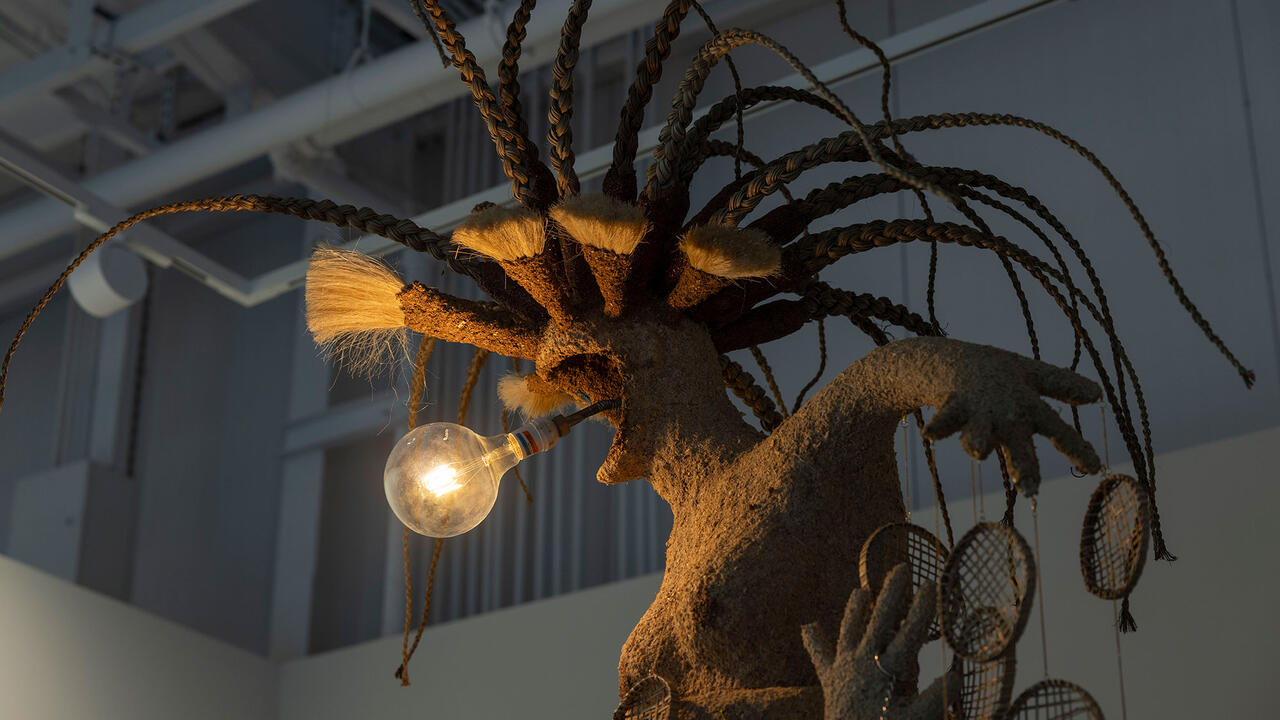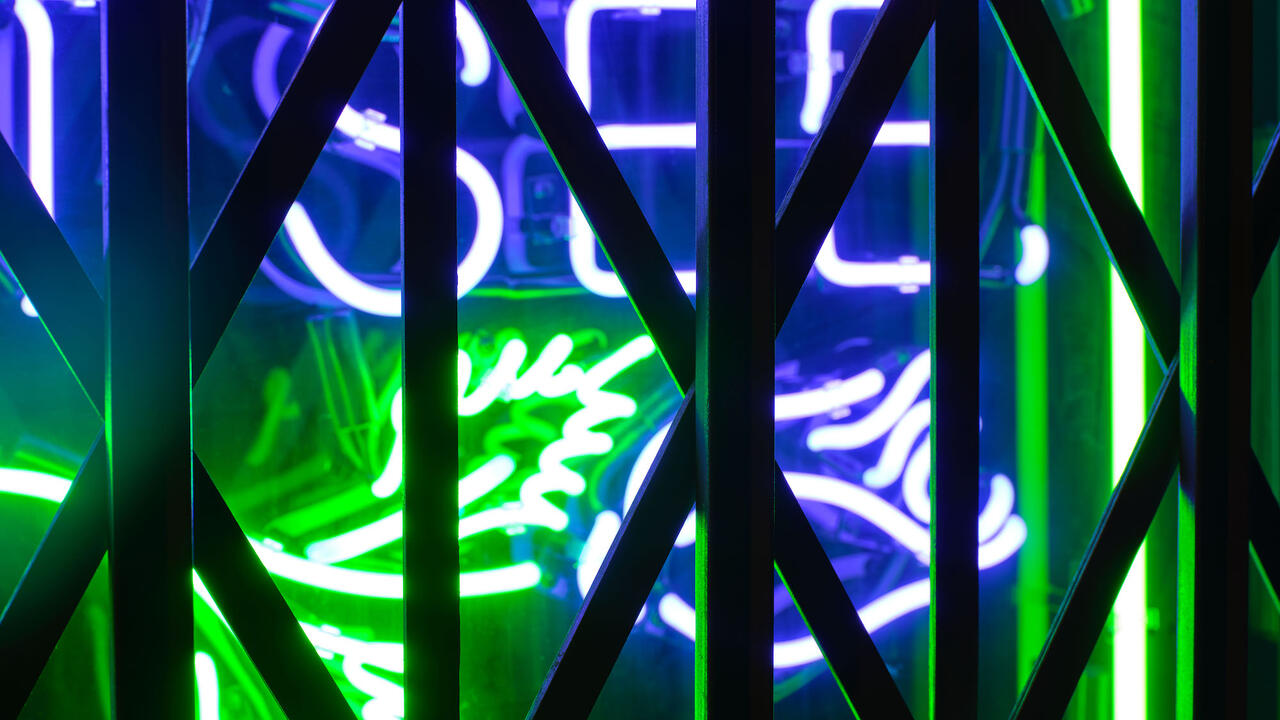Net Narrative

‘Net Narrative’ was a group show of seven artists whose work is either sourced from or invested in the Internet, presented across various online platforms, social networks or retail hubs. The exhibition was presented in three sites: objects in Carlos/Ishikawa; frontispieces on the gallery’s website; and additional information in a downloadable PDF. In most cases, the term ‘narrative’ seemed to refer to the extensive background or research material behind each particular object; rather than how the work itself appears or, indeed, how the exhibition’s works might interrelate.
Iain Ball’s Rare-Earth Sculpture (Cerium) (all works 2012) was installed at the gallery entrance. Its freestanding aluminium frame supported a porcelain basin, above which hung a high-tech water purification flask. Beneath, a small copper-coloured pillbox dangled from red twine. According to the label, this was a ‘hyperdimensional oscilator’, although its precise function was unclear. The work’s title refers to the magnetic mineral found in computer hard drives, the mining of which is increasingly controlled by China. I assume Ball intended some conceptual mining of his own, welding the individual components onto one another. But without immediate (or smart-phone) access to information on these obscure components, the connections remained inert. Nearby, Ben Vickers’ AKA Live Journal (Version 1.0) comprised three stacks of plastic storage boxes, with A4 photocopied images of people’s faces (listed as ‘Facebook pictures’) tacked onto their sides. Inside each box, if one were to snoop like I did, could be found a copy of a book, freshly printed and wrapped neatly in plastic. These boxes might represent semi-private profiles and, as unauthorized viewers, we were not allowed full access to the exchange. The work basically illustrates the experience – the careful prying and false privacy – of online ‘sharing’ on social networks.
In the gallery, several of the works suffered from their offline remove, appearing like the spillages of larger endeavours – preludes, props or aftermaths of narratives located elsewhere. In a few instances, however, material presence (and trashiness) was astutely deployed to reflect back on the brain-dead dynamics of images perpetually rebounding online. Holly White’s Never Forget Always Regret, phone photos then till now (Summer of My Life 2012) comprised pieces of cardboard hanging on flanking sides of the gallery from string thrust across the vaulted ceiling. The dangling shapes were cut like numbers of the Olympics 2012 logo, as well as some basic circles and ovals. Their surfaces were roughly sticky-taped with tinfoil and various low-resolution images. A picture of a dream-catcher was pasted onto one cardboard round. This popular trinket, based on the Native American net for catching dreams, became White’s surrogate web in which low-quality smart-phone photos were stuck, the images of the corporate sponsorship logos that marked every possible surface during this summer’s Olympic Games. Here, they became pixellated and colourless; forced through this kitsch surrogate, their annoying omnipotence was coerced into obsolescence. Katja Novitskova’s Next Best Thing To Being There combined a mass-produced stock image of a forest printed on canvas, with a ‘3D panorama’ view of the same forest shown from an iPad hanging beside it on the gallery wall. On the iPad, viewers could direct their perspective around the forest with their finger. Inside this virtual landscape, Novitskova had animated the ‘original’ canvas onto a tree, and around it hung other weird reproductions: a painting of a young boy, the image of a giant squid and one of a deflated gym ball. This landscape was as captivating as the print was crass, and their odd combination afforded some perspective on technicity, or the subtle impact of technology on modern human experience.
Beyond component pieces, the exhibition highlighted the difficulties of developing gallery shows when so much art is being made, viewed and shared online and when often – however consciously – sculpture seems to be created with its profile, rather than its physical presence, in mind. On Carlos/Ishikawa’s website, approaches differed. Novitskova uploaded a still image, a composite of the cyber-aquatic, so that scrolling down screen was like plunging in a virtual diving bell. Vickers seemed unconcerned with contextual connections and uploaded a 50-minute mix of distorted electro. Ball, like White, Ed Fornieles and Marlie Mul, used the site to link the objects in the gallery with their broader concerns, directing us towards previous works online and sometimes attempting to formally or academically ground it with hyperlinks elsewhere; in Ball’s case to Tim Morton’s online ‘hyperobjects’ lectures. The downloadable publication reproduced screen-grabs of much of the same material, with two commissioned essays and one short story for good measure.
And, with all the added homework, what appealed to me on my browser didn’t necessarily tally with works that seduced me in person. Strategic links, sounds and videos lifted, or certainly expanded, pieces that seemed muted or dumb in the round whereas, somewhat contrarily, in the gallery the really impoverished image-objects came critically to life.














